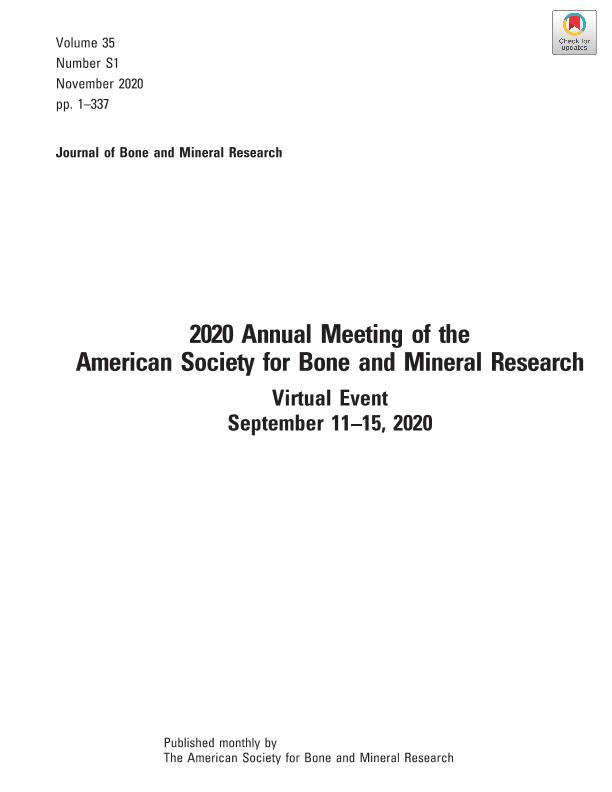Evento
Progesterone (Pg) and Medroxyprogesterone acetate (MPA) regulate same events with opposite actions in bone and vascular cells
Colaboradores:
Civitelli, Roberto
Tipo del evento:
Reunión
Nombre del evento:
2020 Annual Meeting of the American Society for Bone and Mineral Research
Fecha del evento:
11/09/2020
Institución Organizadora:
American Society for Bone and Mineral Research;
Título de la revista:
Journal of Bone and Mineral Research
Editorial:
Wiley
ISSN:
0884-0431
Idioma:
Inglés
Clasificación temática:
Resumen
Bone and cardiovascular diseases are multifactorial clinical entities that often coexist in postmenopausal women. Clinical and epidemiological studies have shown an interesting relationship between high bone turnover and cardiovascular disease mortality. Disorders in bone metabolism reversely correlate with vascular calcification (VCa). Hormone replacement therapy including natural Pg or synthetic progestins such as MPA emerged as a therapeutic option, although the risk/benefit of its use is controversial. VCa developed within atherosclerotic plaque is partly due to the osteogenic transdifferentiation of vascular smooth muscle cells (VSMC). The aim of this work was to investigate the effect of Pg and MPA on cellular/molecular events involved in VCa and in osteoblastogenesis. Primary cultures of calvarial osteoblasts (OB) and aortic VSMC, were in vitro exposed to 10 nM Pg or 10 nM MPA. Measurements of matrix extracellular calcium content and alkaline phosphatase (ALP) activity were employed as osteoblastic differentiation markers. In order to promote osteoblastic differentiation, VSMC were cultured for 21 days in osteogenic medium (10 mM β-glycerophosphate and 4 mM CaCl2). When VSMC were cultured in osteogenic medium (VSMC-OB), treatment with Pg for 21 days significantly reduced ALP activity (15% below control, p<0.02) and calcium content (32% below control, p<0.02). Similar treatment with the synthetic progestin also showed a significant reduction in ALP activity (239.9 ± 21.0 vs. 159.6 ± 19.1 x103 IU/mg protein, control vs MPA, p<0.02), as well as in the extracellular calcium deposition (365.1 ± 38.2 vs 253.6 ± 21.9 µg/mg protein, control vs MPA, p<0.02). Conversely, exposure of OB cells to Pg or MPA significantly increased ALP activity (59%; 290% above control, Pg; MPA, p<0.02) and matrix calcium levels (12%; 55% above control, Pg; MPA, p<0.02). The mechanism of action of Pg and MPA on both cells involves the participation of Pg receptor (PgR), since pre-treatment of cells with RU486, a PgR antagonist, completely reversed the hormonal action. However, we ruled out the involvement of the androgen receptor (AR), since in the presence of the AR antagonist flutamide, the effect of the progestogens was sustained. In conclusion, although Pg and MPA exert opposite effects on OB and VSMC-OB, both steroids would exhibit a potential beneficial effect by promoting osteoblastic differentiation and inhibiting VCa.
Archivos asociados
Licencia
Identificadores
Colecciones
Eventos(INBIOSUR)
Eventos de INSTITUTO DE CIENCIAS BIOLOGICAS Y BIOMEDICAS DEL SUR
Eventos de INSTITUTO DE CIENCIAS BIOLOGICAS Y BIOMEDICAS DEL SUR
Citación
Progesterone (Pg) and Medroxyprogesterone acetate (MPA) regulate same events with opposite actions in bone and vascular cells; 2020 Annual Meeting of the American Society for Bone and Mineral Research; Estados Unidos; 2020; 1-5
Compartir
Altmétricas




